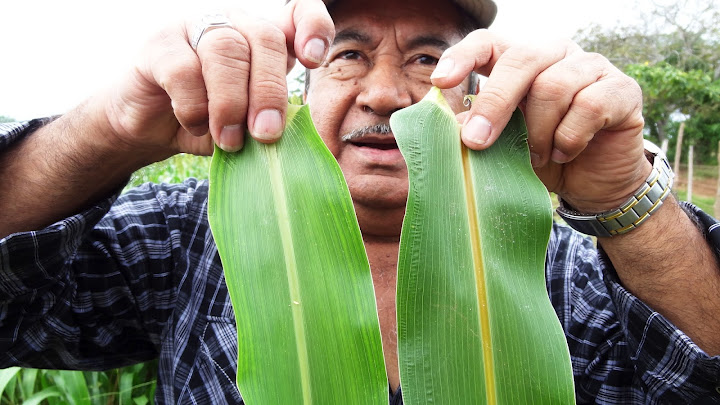Helping Dairy Farmers Produce Greater Quantities of Milk with New Sorghum Forage Varieties in Central America

Rene Clara Valencia demonstrating the brown midrib on the leaf of the bar variety at right as compared to the non-bmr variety at left.
As a result of research of the INTSORMIL CRSP a new sorghum variety, “Sorgo CENTA S-2 bmr” was publicly launched in San Salvador, El Salvador. The new variety is the successful result of the long-term research collaboration between the USAID-funded Sorghum, Millet and Other Grains Collaborative Research Support Program (INTSORMIL CRSP) and the El Salvador national sorghum program of the Centro Nacional de Tecnologia Agropecuaria y Forestal (CENTA). The launch on December 8, 2011 was attended by Dr. John Yohe, Director of the INTSORMIL CRSP, as well as Shamenna K. Gall an agricultural officer from USAID/El Salvador and René Clara Valencia, an INTSORMIL regional coordinator in Central America, CENTA scientist in El Salvador and the sorghum breeder who developed CENTA S-2 bmr.
Seeds of this brown midrib (bmr) variety are being multiplied and will become available to dairy farmers in El Salvador this year to provide more nutritious feed for their cattle, which will result in greater milk and meat yields and consequently increasing the incomes of rural producers. Such “dual-purpose” cultivars that exhibit both good grain and forage production, when combined with improved silage storage methods, have provided high-quality forage for cattle during the dry season, when pastures are limited. These varieties do not require irrigation and are better able to withstand drought than corn and are nearly and equivalent to corn forage in digestibility.
The work to produce this and other sorghum varieties was conducted under a three-year, US$1.1 million associate award from USAID/Washington “Strategic Investment in Rapid Technology Dissemination (SIRTD): Identification and Release of Brown Midrib (bmr) Sorghum Varieties to Producers in Central America and Haiti.” It was awarded to the INTSORMIL CRSP in October 2010, building on earlier research. The award supports the testing and release of new varieties of sorghum that are especially attractive for use as forage for beef and dairy cattle. In 2012 the successful varieties will be distributed to producers in seven countries in Latin America and the Caribbean (Costa Rica, Guatemala, Haiti, Honduras, Nicaragua, El Salvador, and Panama).
The INTSORMIL CRSP, whose leader award ended in September 2011, but is currently being processed for a funded extension through September 2012, has maintained collaborative research activities in thirteen countries in Africa and six countries in Central America and Haiti during this program phase 2006-2012). Its researchers have worked successfully with CENTA in Latin America for 25 years, and fifteen students from El Salvador have received degrees under the CRSP between 1980 and 2009.
Click here to watch a video.
For more information, see http://intsormil.org/smvarietalreleases/FOLLETO%20CENTA.fh10.pdf (in Spanish)
and http://hayandforage.com/other-silage/forage-sorghum-excels-when-water-lacking.
